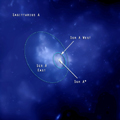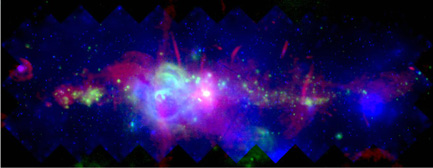An overview of the Chandra mission and goals, Chandra's namesake, top 10 facts.
Classroom activities, printable materials, interactive games & more.
Overview of X-ray Astronomy and X-ray sources: black holes to galaxy clusters.
All Chandra images released to the public listed by date & by category
Current Chandra press releases, status reports, interviews & biographies.
A collection of multimedia, illustrations & animations, a glossary, FAQ & more.
A collection of illustrations, animations and video.
Chandra discoveries in an audio/video format.
Chandra Explores "Downtown" In The Milky Way
June 28, 2004 ::

Illustration of Galactic Center
CXC/A.Hobart |
We live in the suburbs of the giant, spiral Milky Way galaxy. Earth is about 26,000 light years from the teeming, tumultuous Galactic Center where most of the action takes place. On the one hand, that's probably a good thing for fragile creatures such as ourselves. On the other hand, we are also incurably curious and would like to know what's happening there.
For modern-day optical telescopes that routinely look at objects billions of light years away, examining a region only 26,000 light years distant shouldn't present much of a problem. However, it's not that simple. Like many crowded cities on Earth, the smog in the Galactic Center is terrible. Dust and gas produced by millions of massive stars makes it impossible for the most powerful optical telescopes to see into this region.
Fortunately, other options are now available. Radio, infrared, X-ray and gamma-ray radiation can travel through the Galactic smog and be captured by telescopes sensitive to these forms of light. Using this information, astronomers have been gradually piecing together a picture of the center of the
Milky Way. Chandra's unique ability to resolve X-ray sources as small as a tenth of a light year across in the Galactic Center has led to major advances in our understanding of the high-energy activity there. It has also posed some mysteries.

Chandra Image of Galactic Center |
A
panoramic X-ray view extending 400 light years by 900 light years shows that, even at this distance from the center of the Galaxy, conditions are getting crowded, and the energy level is increasing dramatically. Supernova remnants (SNR 0.9-0.1, probably the X-ray Thread, and Sagittarius A East), bright binary X-ray sources containing a black hole or a neutron star (the 1E sources), and hundreds of unnamed point-like sources due to neutron stars or white dwarfs light up the region. The massive stars in the Arches and other star clusters (the DB sources) will soon explode to produce more supernovas, neutron stars, and black holes.
Infrared and radio telescopes have also revealed giant star-forming molecular clouds (Sagittarius A, B1, B2 and C, and the
cold gas cloud near the Radio Arc), the edges of which are glowing with X-rays because of heating from nearby supernovas.
All this commotion takes place in a diffuse cloud of hot gas that shows up as extended X-ray emission. The gas appears to have two components - a 100-million degree Celsius part and a 10-million degree component. This diffuse X-ray glow gets brighter toward the Galactic Center. The high temperature of the diffuse gas poses a problem - it should flow out of the Galactic Center in about 10,000 years, requiring continual replenishment and heating.
The massive stars in the
Arches and other star clusters can supply the gas - the X-ray sources associated with these clusters show that they are blowing away a prodigious amount of matter - but they are unlikely to supply the heating mechanism. Another possibility is that magnetic fields are involved in heating the gas, or confining it to the center of the galaxy. The radio image, which is a tracer of magnetic fields in this region, shows that the magnetic fields are certainly there. However, their structure appears unlikely to be capable of confining the hot gas.

Sagittarius A with labels |
Within a dozen light years of the Galactic Center, the hurly burly increases. Sagittarius A, the bright blob in the center, is composed of three main parts -
Sagittarius A East, Sagittarius A West, and
Sagittarius A*. Sagittarius A East is the remnant of a supernova that stirred things up about 10,000 years ago (plus, of course, the 26,000 years that it takes the light to reach us from the Galactic Center).
Sagittarius A West is a spiral-shaped structure of gas that may be headed toward Sagittarius A*, the supermassive black hole that marks the center of the Milky Way Galaxy. Sgr A* contains about 3 million times the mass of the Sun, and is gaining weight daily as it pulls in more material.

Sagittarius A* |
The mystery surrounding Sgr A* is why it is not growing faster. All the matter being spewed out by those massive stars should provide the central black hole with a good steady source of food, yet the X-ray power of Sgr A*, normally a good indicator of the rate of mass being swallowed by the black hole, is unusually low. Chandra has caught Sgr A* in the act of snacking - it produced a series of bright flares - but the amount consumed was small, about the weight of a comet.
Explanations for the eating habits of Sgr A* abound. One is that the gas around it is simply too hot - blame the Sgr A East explosion for that. According to this idea, we are seeing Sgr A* in a quiet period, and it may get back on a regular feeding schedule in the future. Another is that the winds from the massive stars are blowing too fast to be captured by the supermassive black hole. A black hole is in a way like a big, slow dog. If a rabbit stays far enough away, it can escape, but if it ventures too close, . . .

Sagittarius A* Animation |
Finally, there is the possibility that it is eating normally and we don't know it. Either the gas is not spiraling into the black hole, falling in directly, so it radiates very few X-rays on the way in, or most of the X-rays are beamed away from us.
As with any exciting, vibrant downtown area of a big city, it obviously takes many visits to know what's going on.










